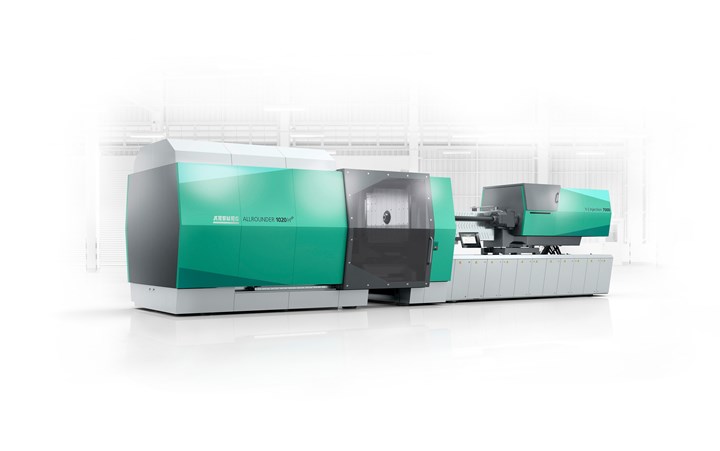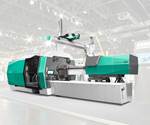Injection Molding: Arburg Introduces Its Largest Packaging Machine Ever
The hybrid press features 660 tons of clamp force, 40 inches between its tiebars and shot weights up to 148 ounces.
Arburg reports that the hybrid Allrounder 1020 H Packaging machine, with 660 tons of clamp force and 40 inches between its tiebars, is the largest the company has ever built that’s specifically designed for packaging applications. Unveiled at K 2019 (read more in the September 2019 K Preview), Arburg says the hybrid machine, with an electric clamp and hydraulic-accumulator injection, is suited for both high-cavitation molds or larger containers with volumes of up to 8 gallons. A barrier screw ensures homogeneous melt preparation and a high material throughput.
The new size 7000 injection unit has a maximum shot weight of around 4200 grams (148 ounces) in (PS). Shot building occurs concurrently with other machine operations via a servo-electric dosing drive. Hydraulic accumulators increase injection speed, with screw speed and position actively controlled throughout the cycle. Active acceleration and deceleration enable fast injection times, and injection can be started simultaneously with mold close.

At K 2019, the Allrounder 1020 H molded round thin-walled PP cups with a weight of 13 grams from an 8+8-cavity stack mold in a cycle time of 4.3 seconds.
Related Content
-
Consistent Shots for Consistent Shots
An integral supplier in the effort to fast-track COVID-19 vaccine deployment, Retractable Technologies turned to Arburg and its PressurePilot technology to help deliver more than 500 million syringes during the pandemic.
-
Arburg Open House Emphasizes Turnkey Capabilities
Held at the company’s U.S. headquarters in Rocky Hill, Connecticut, the event featured seven exhibits, including systems that were designed, sourced and built in the U.S.
-
Next-Generation All-Electric and Vertical Injection Molding Machines
Sodick Plustech’s VR-G and MS-G2 Series both utilize the company’s proprietary V-Line technology, separating plasticizing and injection functions, and have upgraded displays, energy efficiency, response time and more.


